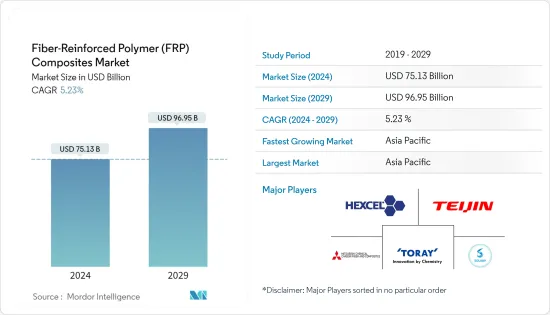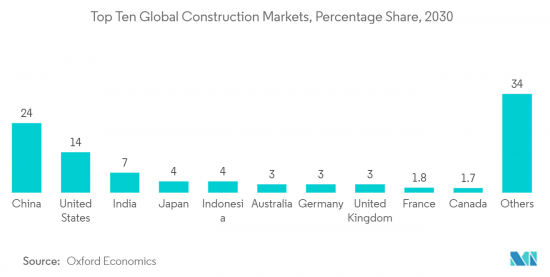 |
市場調査レポート
商品コード
1406079
繊維強化ポリマー(FRP)複合材料:市場シェア分析、産業動向と統計、2024年~2029年の成長予測Fiber-Reinforced Polymer (FRP) Composites - Market Share Analysis, Industry Trends & Statistics, Growth Forecasts 2024 - 2029 |
||||||
● お客様のご希望に応じて、既存データの加工や未掲載情報(例:国別セグメント)の追加などの対応が可能です。 詳細はお問い合わせください。
| 繊維強化ポリマー(FRP)複合材料:市場シェア分析、産業動向と統計、2024年~2029年の成長予測 |
|
出版日: 2024年01月04日
発行: Mordor Intelligence
ページ情報: 英文 150 Pages
納期: 2~3営業日
|
- 全表示
- 概要
- 目次
繊維強化ポリマー複合材料市場規模は、2024年に751億3,000万米ドルと推定され、2029年には969億5,000万米ドルに達すると予測され、予測期間中(2024年~2029年)のCAGRは5.23%で成長すると予測されます。

COVID-19は2020年から2021年半ばにかけて市場にマイナスの影響を与えました。パンデミックのため、建設および製造活動が一時的に停止し、これらの産業で使用される繊維強化ポリマー複合材料を含む材料市場の妨げとなった。しかし、パンデミック後は産業が回復し、市場は今後も成長軌道を維持すると予想されます。
主なハイライト
- 短期的には、建設セクターからの需要の増加と、航空宇宙産業および自動車産業におけるエネルギー効率に対する需要の高まりが、市場の成長を牽引すると予想されます。
- その反面、代替品の入手可能性が市場の成長を妨げると予想されます。
- とはいえ、FRP材料の新しい先進的な形態の開拓や、輸送産業で使用される複合材料の開発は、予測期間中、市場の機会として機能すると思われます。
- アジア太平洋地域は、中国、インド、日本などの国々からの消費の増加により、予測期間中最大の市場を占めると予想されます。
繊維強化ポリマー(FRP)複合材料の市場動向
建設分野からの需要増加
- 繊維強化ポリマー(FRP)複合材料は、ポリエステルまたはエポキシ樹脂を繊維で強化した人工材料です。FRPで作られた最終製品は、丈夫で耐久性があり、薄くて軽い素材です。
- オックスフォード・エコノミクスによれば、世界の建設生産高は今後15年間で4兆2,000億米ドル以上に成長し、2037年には13兆9,000億米ドルに達すると予想されています。
- インド、バングラデシュ、その他のASEAN諸国などにおける急速な都市化と、一人当たり平均所得の減少に伴う人口増加が、建設活動の大幅な増加を促すと思われます。
- 主要経済国における都市部への急速な移住、住宅建設のための不動産市場における政府支出の増加、高級住宅に対する需要の高まりといった要因が、調査対象市場の成長に利益をもたらすと思われます。
- 北米では、米国が建設業界の最大市場です。米国国勢調査局によると、米国では住宅着工件数が顕著に増加しており、住宅建設部門が盛んであることを示しています。
- 2023年5月の民間住宅着工戸数は季節調整済み年率163万1,000戸に達し、2023年4月の改定値と比べて21.7%の大幅増となった。2023年5月の一戸建て住宅着工戸数も18.5%の大幅な伸びを記録しました。これらの数字は、住宅に対する旺盛な需要と、住宅建設における調査対象市場の潜在性を示しています。
- さらに、AIA(米国建築家協会)の建設コンセンサス予測パネルによれば、2022年の非住宅建築支出は5.4%に拡大しました。さらに、新規の民間非住宅建築物に対する支出は、米国では2022年に5,390億米ドルを超えてピークに達しました。2023年までには、商業、工業、施設のすべての主要カテゴリーで、少なくともそれなりに健全な増加が見られると予測されています。
- Eurostatによると、2022年の欧州の建設セクターは、EU復興基金からの新規投資により2.5%成長しました。2022年の主な建設プロジェクトは非住宅建設(オフィス、病院、ホテル、学校、工業用建物)で、活動全体の31.3%を占める。
- ドイツは欧州最大の建設産業国です。ドイツ政府は、今後数年間の建設活動に約3,750億ユーロ(4,091億7,000万米ドル)を割り当てています。さらに、25万戸から40万戸の住宅を建設する計画も明らかにしており、このプロジェクトは市、民間デベロッパー、公共住宅当局にとって絶好の投資機会となっています。
- このように、このような要因はすべて、予測期間中の繊維強化ポリマー複合材市場の成長を促進すると思われます。

市場を独占するアジア太平洋地域
- 予測期間中、アジア太平洋地域が繊維強化ポリマー(FRP)複合材料市場を独占すると予想されます。中国、インド、日本などの国々からの用途に対する需要が高いため、この地域ではFRPコンポジットの需要が増加しています。
- アジア太平洋地域の建設セクターは世界最大です。人口増加、中間所得層の増加、都市化により、健全なペースで増加しています。アジア太平洋地域では、中国とインドにおける住宅建設市場の拡大により、住宅が最も高い成長を記録すると予想されます。
- 世帯所得水準の上昇と農村部から都市部への人口移動が相まって、中国における住宅建設セクターの需要は引き続き拡大すると予想されます。
- 加えて、中国は世界最大の建設市場を有しており、世界全体の建設投資の20%を占めています。中国は、2030年までに建築物に13兆米ドル近くを投じると予想されており、繊維強化ポリマー複合材料市場にとって明るい市場見通しが生まれています。
- さらに、建設部門はインド経済の成長にとって重要な柱です。インド政府は住宅建設を積極的に後押ししており、約13億人に住宅を供給することを目指しています。
- 例えば、マルチ・スズキ・インディアは2022年11月、新施設の設立や新モデルのイントロダクションなど、さまざまなプロジェクトに8億6,512万米ドルを投資すると発表しました。
- 2022年1月には、ホンダの中国合弁会社である東風汽車有限公司が武漢での電気自動車製造工場の開発を発表しました。東風本田汽車の新施設は2024年に開設され、年間12万台の生産能力を持つ。
- 東南アジア諸国連合自動車連盟によると、アジア太平洋地域の2022年の自動車生産台数は483万3,744台、オートバイ・スクーターは363万6,453台だった。同年の自動車販売台数は342万4,935台以上、二輪車販売台数は404万9,598台以上です。
- アジア太平洋地域におけるエレクトロニクス製品の需要は、主に中国、インド、日本からもたらされます。中国は、人件費の安さと柔軟な政策により、エレクトロニクスメーカーにとって強力で有利な市場です。
- 中国市場は世界最大で、先進工業国の合計市場よりも大きいです。2022年、中国の電子産業は14%拡大し、2023年には8%の成長が見込まれています。
- インドでは、Make in India、National Policy of Electronics、Net Zero Imports in Electronics、Zero Defect Zero Effectなど、国内製造業の成長、輸入依存度の低下、輸出の活性化、製造業へのコミットメントを提供する政府の制度により、エレクトロニクス部門が急成長しています。
- したがって、こうした要因すべてが、予測期間中の繊維強化ポリマー複合材市場の成長を促進すると思われます。
繊維強化ポリマー(FRP)複合材料産業の概要
世界の繊維強化ポリマー(FRP)複合材料市場は、その性質上、部分的に統合されており、主要企業5社が調査対象市場の主要シェアを占めています。主要企業には、Hexcel Corporation、Teijin Limited、Toray Industries Inc.、Solvay、Mitsubishi Chemical Carbon Fiber and Composites Inc.などが含まれる(順不同)。
その他の特典:
- エクセル形式の市場予測(ME)シート
- 3ヶ月間のアナリスト・サポート
目次
第1章 イントロダクション
- 調査の前提条件
- 調査範囲
第2章 調査手法
第3章 エグゼクティブサマリー
第4章 市場力学
- 促進要因
- 建設セクターからの需要増加
- 航空宇宙産業と自動車産業におけるエネルギー効率に対する需要の高まり
- 抑制要因
- 繊維強化ポリマー(FRP)材料の欠点
- 代替品の入手可能性
- 業界バリューチェーン分析
- ポーターのファイブフォース分析
- 供給企業の交渉力
- 消費者の交渉力
- 新規参入業者の脅威
- 代替品の脅威
- 競合の程度
第5章 市場セグメンテーション(市場規模)
- 繊維タイプ
- ガラス繊維強化ポリマー
- 炭素繊維強化ポリマー
- アラミド繊維強化ポリマー
- バサルト繊維強化ポリマー
- その他の繊維タイプ
- エンドユーザー産業
- 建築・建設
- 輸送
- 電気・電子
- その他のエンドユーザー産業
- 地域
- アジア太平洋
- 中国
- インド
- 日本
- 韓国
- その他のアジア太平洋
- 北米
- 米国
- カナダ
- メキシコ
- 欧州
- ドイツ
- 英国
- フランス
- イタリア
- その他の欧州
- 南米
- ブラジル
- アルゼンチン
- その他の南米
- 中東・アフリカ
- サウジアラビア
- 南アフリカ
- その他の中東・アフリカ
- アジア太平洋
第6章 競合情勢
- M&A、合弁事業、提携、協定
- 市場ランキング分析
- 主要企業の戦略
- 企業プロファイル
- Aegion Corporation
- AGC Chemicals Americas
- Gurit
- GSC
- Hexcel Corporation
- Kordsa Teknik Tekstil A.S.
- Mitsubishi Chemical Carbon Fiber and Composites Inc.
- Nippon Electric Glass Co. Ltd.
- Owens Corning
- Park Aerospace Corp.
- SGL carbon
- Solvay
- TEIJIN LIMITED
- TORAY INDUSTRIES INC.
第7章 市場機会と今後の動向
- FRP材料の新しい高度な形態の開発
- 輸送産業からの複合材料分野における開発とパートナーシップ

The Fiber-Reinforced Polymer Composites Market size is estimated at USD 75.13 billion in 2024, and is expected to reach USD 96.95 billion by 2029, growing at a CAGR of 5.23% during the forecast period (2024-2029).
COVID-19 negatively impacted the market from 2020 to mid-2021. Due to the pandemic, construction and manufacturing activities were temporarily stopped, which hampered the market for materials, including fiber reinforced polymer composites to be used in these industries. However, post-pandemic, the industries recovered, and the market is expected to retain its growth trajectory in the coming years.
Key Highlights
- Over the short term, the increasing demand from the construction sector and the growing demand for energy efficiency in the aerospace and automotive industries are expected to drive the market's growth.
- On the flip side, the availability of substitutes is expected to hinder the market's growth.
- Nevertheless, the development of new advanced forms of FRP materials and the development of composite materials to be used in the transportation industry are likely to act as opportunities for the market over the forecast period.
- The Asia-Pacific is expected to represent the largest market over the forecast period, owing to the increasing consumption from countries such as China, India, and Japan.
Fiber Reinforced Polymer (FRP) Composites Market Trends
Increasing Demand from the Construction Sector
- Fiber-reinforced polymer (FRP) composites are engineered materials composed of polyester or epoxy resin reinforced with fiber. The final product made of FRP is a strong, durable, thin, and lightweight material, and it has the advantage of quick installation.
- As per Oxford Economics, the global construction output is expected to grow to over USD 4.2 trillion over the next 15 years and reach a value of USD 13.9 trillion in 2037, driven by the superpower construction markets of China, the United States, and India.
- Rapid urbanization in countries such as India, Bangladesh, and other ASEAN countries, and population growth along with declining average per capita income will drive a significant increase in construction activities.
- Factors such as rapid urban migration in major economies, increased government spending in the real estate market for residential construction, and the growing demand for high-class residential homes are likely to benefit the growth of the market studied.
- In North America, the United States is the largest market for the construction industry. According to the US Census Bureau, housing starts have shown a notable increase in the United States, indicating a thriving residential construction sector.
- In May 2023, privately owned housing reached a seasonally adjusted annual rate of 1,631,000, a significant rise of 21.7% compared to the revised April 2023 estimate. Single-family housing starts also experienced a substantial growth rate of 18.5% in May 2023. These figures indicate a strong demand for housing and a potential market for the studied market in residential construction.
- Moreover, according to the AIA (American Institute of Architects) Construction Consensus Forecast Panel, nonresidential building construction spending expanded to 5.4% in 2022. Further, expenditure on new private nonresidential buildings peaked in the United States at over USD 539 billion in 2022. By 2023, all major commercial, industrial, and institutional categories are projected to witness at least reasonably healthy gains.
- According to Eurostat, the European construction sector grew by 2.5% in 2022 due to new investments from the EU Recovery Fund. The major construction projects in 2022 accounted for nonresidential construction (offices, hospitals, hotels, schools, and industrial buildings), accounting for 31.3% of total activity.
- Germany has the largest construction industry in Europe. The German government has allocated around EUR 375 billion (USD 409.17 billion) in construction activities in the coming years. In addition, it also revealed plans to build 250,000 to 400,000 housing units, making this project a great investment opportunity for the city, private developers, and public housing authorities.
- Thus, all such factors are likely to drive the growth of the fiber-reinforced polymer composites market during the forecast period.

Asia-Pacific Region to Dominate the Market
- Asia-Pacific is expected to dominate the fiber-reinforced polymer (FRP) composites market during the forecast period. Due to the high demand for applications from countries like China, India, and Japan, the demand for FRP composites is increasing in the region.
- The construction sector in the Asia-Pacific region is the largest in the world. It is increasing at a healthy rate, owing to the rising population, increase in middle-class income, and urbanization. The highest growth for housing is expected to be registered in the Asia-Pacific region, owing to the expanding housing construction markets in China and India.
- The rising household income levels, combined with the population migrating from rural to urban areas, are expected to continue to drive the demand for the residential construction sector in China.
- In addition, the country has the largest construction market in the world, encompassing 20% of all construction investments globally. China is expected to spend nearly USD 13 trillion on buildings by 2030, creating a positive market outlook for the fiber-reinforced polymer composites market.
- Furthermore, the construction sector is an important pillar for the growth of the Indian economy. The Indian government has been actively boosting housing construction, aiming to provide houses to about 1.3 billion people.
- Many Automakers are investing heavily in various segments of the industry; for instance, in November 2022, Maruti Suzuki India announced an investment of USD 865.12 million on various projects, including new facilities set-up and introduction of new models.
- In January 2022, Honda's Chinese joint venture with Dongfeng Motor Corporation Ltd. announced the development of an electric vehicle manufacturing factory in Wuhan. The new Dongfeng-Honda Automobile facility will be opened in 2024 with a production capacity of 120,000 units per year.
- According to the Association of Southeast Asian Nations Automotive Federation, Asia Pacific produced 4,383,744 units of motor vehicles and 3,636,453 units of motorcycles and scooters in 2022. It sold over 3,424,935 and 4,049,598 units of motor vehicles and two-wheelers, respectively, in the same year.
- The demand for electronics products in the Asia-Pacific region majorly comes from China, India, and Japan. China is a strong, favorable market for electronics producers, owing to the country's low labor cost and flexible policies.
- China's market is the largest in the world, even larger than the combined markets of all industrialized countries. In the year 2022, the Chinese electronic industry expanded by 14% and is expected to grow by 8% in 2023.
- In India, the electronics sector is seeing rapid growth owing to government schemes such as Make in India, National Policy of Electronics, Net Zero Imports in Electronics, and Zero Defect Zero Effect, which offer a commitment to growth in domestic manufacturing, lowering import dependence, energizing exports, and manufacturing.
- Thus, all such factors are likely to drive the growth of the fiber-reinforced polymer composites market during the forecast period.
Fiber Reinforced Polymer (FRP) Composites Industry Overview
The global fiber-reinforced polymer (FRP) composites market is partially consolidated in nature, with the top five players accounting for a major share of the market studied. Some of the key players include (not in any particular order) Hexcel Corporation, Teijin Limited, Toray Industries Inc., Solvay, and Mitsubishi Chemical Carbon Fiber and Composites Inc., among others.
Additional Benefits:
- The market estimate (ME) sheet in Excel format
- 3 months of analyst support
TABLE OF CONTENTS
1 INTRODUCTION
- 1.1 Study Assumptions
- 1.2 Scope of the Study
2 RESEARCH METHODOLOGY
3 EXECUTIVE SUMMARY
4 MARKET DYNAMICS
- 4.1 Drivers
- 4.1.1 Increasing Demand from the Construction Sector
- 4.1.2 Growing Demand for Energy Efficiency in the Aerospace and Automotive Industries
- 4.2 Restraints
- 4.2.1 Fiber-reinforced Polymer (FRP) Material Shortcomings
- 4.2.2 Availability of Substitutes
- 4.3 Industry Value Chain Analysis
- 4.4 Porter's Five Forces Analysis
- 4.4.1 Bargaining Power of Suppliers
- 4.4.2 Bargaining Power of Consumers
- 4.4.3 Threat of New Entrants
- 4.4.4 Threat of Substitute Products and Services
- 4.4.5 Degree of Competition
5 MARKET SEGMENTATION (Market Size in Value)
- 5.1 Fiber Type
- 5.1.1 Glass Fiber-reinforced Polymer
- 5.1.2 Carbon Fiber-reinforced Polymer
- 5.1.3 Aramid Fiber-reinforced Polymer
- 5.1.4 Basalt Fiber-reinforced Polymer
- 5.1.5 Other Fiber Types
- 5.2 End-user Industry
- 5.2.1 Building and Construction
- 5.2.2 Transportation
- 5.2.3 Electrical and Electronics
- 5.2.4 Other End-user Industries
- 5.3 Geography
- 5.3.1 Asia-Pacific
- 5.3.1.1 China
- 5.3.1.2 India
- 5.3.1.3 Japan
- 5.3.1.4 South Korea
- 5.3.1.5 Rest of Asia-Pacific
- 5.3.2 North America
- 5.3.2.1 United States
- 5.3.2.2 Canada
- 5.3.2.3 Mexico
- 5.3.3 Europe
- 5.3.3.1 Germany
- 5.3.3.2 United Kingdom
- 5.3.3.3 France
- 5.3.3.4 Italy
- 5.3.3.5 Rest of Europe
- 5.3.4 South America
- 5.3.4.1 Brazil
- 5.3.4.2 Argentina
- 5.3.4.3 Rest of South America
- 5.3.5 Middle-East and Africa
- 5.3.5.1 Saudi Arabia
- 5.3.5.2 South Africa
- 5.3.5.3 Rest of Middle-East and Africa
- 5.3.1 Asia-Pacific
6 COMPETITIVE LANDSCAPE
- 6.1 Mergers and Acquisitions, Joint Ventures, Collaborations, and Agreements
- 6.2 Market Ranking Analysis
- 6.3 Strategies Adopted by Leading Players
- 6.4 Company Profiles
- 6.4.1 Aegion Corporation
- 6.4.2 AGC Chemicals Americas
- 6.4.3 Gurit
- 6.4.4 GSC
- 6.4.5 Hexcel Corporation
- 6.4.6 Kordsa Teknik Tekstil A.S.
- 6.4.7 Mitsubishi Chemical Carbon Fiber and Composites Inc.
- 6.4.8 Nippon Electric Glass Co. Ltd.
- 6.4.9 Owens Corning
- 6.4.10 Park Aerospace Corp.
- 6.4.11 SGL carbon
- 6.4.12 Solvay
- 6.4.13 TEIJIN LIMITED
- 6.4.14 TORAY INDUSTRIES INC.
7 MARKET OPPORTUNITIES AND FUTURE TRENDS
- 7.1 Development of New Advanced Forms of FRP Materials
- 7.2 Developments and Partnerships In the Field of Composite Material From the Transportation Industry
